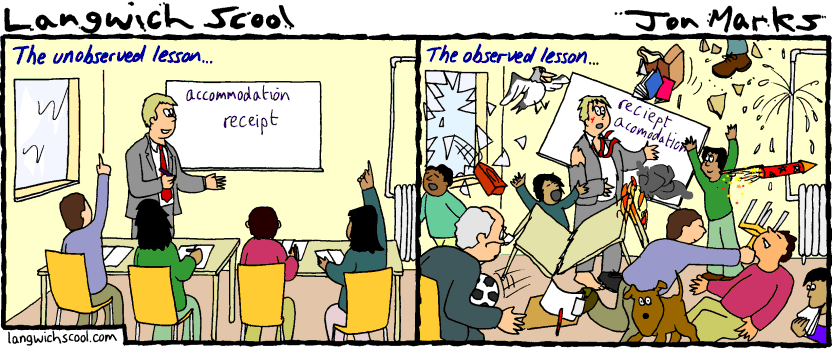Today I conducted my twentieth classroom visit of the year. As always, I was impressed by the range of different attributes displayed by my colleagues: mature rapport with students, use of humour in class, creativity in classroom activities and assignments, a clear format for whole-group discussions, balance between student-centred and teacher-centred moments, use of technology tools, knowledge about the subject, and more. I always find inspiration and a reminder of the variety in our most successful teaching strategies.
In my role as Responsable de la formation professionnelle, I want to encourage more classroom visits. I believe classroom visits are beneficial for several reasons:
1. Classroom visits encourage a collegial atmosphere at school.What better way to be aware of each other’s strengths as educators than to experience them first-hand? Similarly, being visited challenges us to consider the experience of those who come to our class (i.e. our students), and perhaps to adapt our teaching/planning accordingly.
2. Classroom visits model the type of healthy collaboration we want to see in our students.Let’s practise what we preach: visiting each other opens up the type of academic/professional exchange that our students would benefit from. In addition, our students will observe these exchanges, and realise their potential.
3. Classroom visits can have a direct impact on our teaching.From visits, I have personally drawn ideas for materials, assignments, classroom set-up, displays, technology tools and projects. In addition, the features that strike me during visits often become a topic for self-reflection and could lead to modifications in my own practice.
4. Classroom visits can be the starting point for further exploration and discussion.A number of key ideas have arisen from post-visit discussions with colleagues, which I continue to reflect upon or which have led to further research.
So yes, I believe classroom visits should be a more regular feature of our teaching practice. If we engaged in visits (as visitor and as host) more consistently, we would reduce the feelings of nervousness, vulnerability, being on display, being judged or any of the other roots of anxiety we have developed around this exercise. However, I am also aware that there are protocols for successful classroom visits—we must move away from formats that suggest an “appraisal” or “evaluation” of each other, away from formats that hinge on the element of surprise, away from formats of a one-way exchange. (The comic strip above points precisely at why an “evaluation” format does not allow us to grow from an experience where we feel judged.)
One of my preferred formats, which I hope we can embark on at an institutional level, would be collegial pairings.
a. The activity is based on the premise that teachers can learn from each other, and that teachers are able to collect useful data for each other.
b. Two teachers decide to work together. They meet before their visits, and discuss some of their questions with regards to their own teaching. This could be done as a list or brainstorm, or by ticking items from a checklist. (For ideas, see the document “Classroom visits.April2017”, attached.)
c. Together, the two teachers identify one feature for the colleague to focus on. For example, Teacher A tells Teacher B that she is interested in knowing how time is allocated for teacher-centred vs student-centred exchanges in the class; Teacher B tells Teacher A he wants to know to what extent he is showing differentiation in class.
d. Also together, the two teachers decide on a method for obtaining data from the visit.
In the first example above, Teacher B might help Teacher A by documenting how many exchanges are triggered by the teacher vs the student, or by calculating the amount of time each person in the class speaks for, or perhaps by completing a more complex matrix of the types of interactions during the lesson–teacher to class, teacher to student, student to class, student to student, silent work, etc. (See a sample matrix in the document “minute by minute”, attached.)
In the second example, Teacher A might support Teacher B by taking qualitative notes during the lesson on techniques for how work was tailored, how the teacher monitored individual student’s progress, how they checked for understanding, etc.
e. The visitor shares the data with their colleague: this can be done in writing, or during a one-to-one meeting. There should be a follow-up meeting to discuss the data and for the person visited to ask any questions of the visitor. Because this is done as a two-way exchange, both teachers should feel supportive of and supported by the other in reflecting/improving on their practice.
I imagine that if we did one of these exchanges every term (or twice a year) and worked with different partners –sometimes within our department or section, and other times with a completely fresh outlook– we would move beyond the discomfort to an appreciation of the positive impact we can make on each other’s teaching, and to an appreciation of how others can help us improve in a non-threatening way.
Finally, I want to commend the teachers who have welcomed me into their classroom and who have factored me into their planning: introducing me to the students, inviting the students to give me a summary of the topic they are studying, producing an extra copy of the material for me, including me when separating the class into groups, sharing with me how that particular lesson fits in with what they have done previously/will do in the future. As we develop a culture for these collegial exchanges, both our students and our teachers will grow in confidence (and pride!) with regards to classroom visits.
